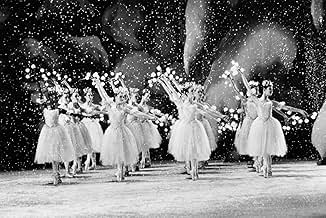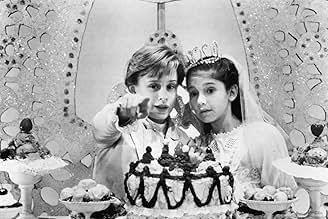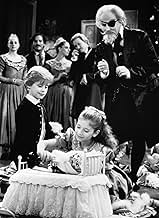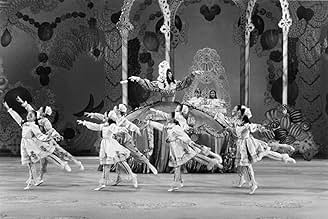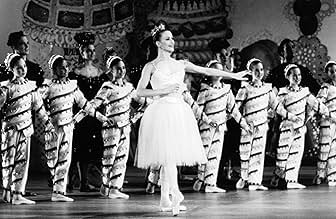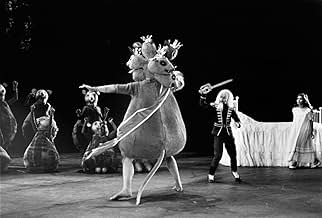PUNTUACIÓN EN IMDb
5,9/10
2,7 mil
TU PUNTUACIÓN
En Nochebuena, una niña llamada Marie se duerme después de una fiesta en su casa y sueña con un mundo fantástico donde los juguetes se vuelven más grandes que la vida.En Nochebuena, una niña llamada Marie se duerme después de una fiesta en su casa y sueña con un mundo fantástico donde los juguetes se vuelven más grandes que la vida.En Nochebuena, una niña llamada Marie se duerme después de una fiesta en su casa y sueña con un mundo fantástico donde los juguetes se vuelven más grandes que la vida.
Reseñas destacadas
I'm not a ballet expert, but I love this production. It's interesting to dissect because there are two camps for this very famous 110 year-old ballet: those who like it as a children's story and those who like it as an adult's. It's been staged both ways in the past as others have already mentioned. This version allows the kids to be front and center, but it has some stellar, sophisticated moments in it as well: the Act 1 finale dance of the snowflakes is a stellar moment of beauty and style, with its ice-blue lighting and costuming and multi-racial Corps De ballet. In Act 2, there's no contest: amongst the innocent dances of the sweets, 'Arabian Coffee' soloist Wendy Whelan sexily attacks the stage in cat-like fashion. The pink-and-purple lighting and floating cinematography and the dancer's serpent-like movements do not resemble any other moment in this already polished film, and one can't help but think that director Emile Ardolino deliberately planned it that way. (It's like watching Ann Reinking or Carol Haney on the Broadway stage.) As far as the smirking Macaulay Culkin is concerned, his presence didn't bother me since he was the right age at the time of filming (and did have some ballet background) and frankly, he smirks in most films he's in. What're you gonna do?
This was so beautiful. I am a ballerina and I have played both the Sugar Plum Fairy and Marie in numerous productions of this, but I have to admit that this is IT. This is the ultimate #1 version of this classical ballet. It was so beautiful. The music is absolutely marvelous and the scenery is gorgeous. The woman who plays the Sugar Plum Fairy is absolutely beautiful and does a fabulous job! I saw the Broadway version of this on a visit to NYC and I have to admit that this version was better than the one I saw there. George Balachine does amazing ballet, I wish I could study with him at his School of Ballet. And the composer(I know who it is, but I cant spell his name) is a musical genius. I give it 10/10.
As far as I can recall, Balanchine's alterations to Tchaikovsky's score are as follows:
1) The final section of the Grossvatertanz (a traditional tune played at the end of a party) is repeated several times to give the children a last dance before their scene is over.
2) A violin solo, written for but eliminated from Tchaikovsky's score for The Sleeping Beauty, is interpolated between the end of the party scene and the beginning of the transformation scene. Balanchine chose this music because of its melodic relationship to the music for the growing Christmas tree that occurs shortly thereafter.
3) The solo for the Sugar Plum Fairy's cavalier is eliminated.
It seems to me the accusation that Balanchine has somehow desecrated Tchaikovsky's great score is misplaced.
1) The final section of the Grossvatertanz (a traditional tune played at the end of a party) is repeated several times to give the children a last dance before their scene is over.
2) A violin solo, written for but eliminated from Tchaikovsky's score for The Sleeping Beauty, is interpolated between the end of the party scene and the beginning of the transformation scene. Balanchine chose this music because of its melodic relationship to the music for the growing Christmas tree that occurs shortly thereafter.
3) The solo for the Sugar Plum Fairy's cavalier is eliminated.
It seems to me the accusation that Balanchine has somehow desecrated Tchaikovsky's great score is misplaced.
Those who have given this production such a low rating probably have never seen the celebrated George Balanchine production live onstage, or are letting their disdain for the star casting of Macaulay Culkin influence their judgement. The Atlanta Ballet was fortunate enough, from the 1960's to the 1980's, to be the first ballet company authorized to stage this production other than the New York City Ballet, and I have seen it live onstage several times. I can assure readers that the film is a quite accurate rendering of this production, and that the use of a child with limited dancing abilities in the title role is not a cheap stunt dreamed up to showcase Culkin; it was Balanchine's idea to use a child in this role, just as it was his idea to use a child for the role of Marie. The "heavy" dancing is left to the adults in the story.
This is deliberately a stagebound film; in a way, it resembles Laurence Olivier's "Othello". Exactly as in that film, the sets of the stage production have been enlarged to the size of a movie soundstage, but not made any less artificial, and the ballet is straightforwardly photographed with discreet closeups, and without the distracting "music video" quick cuts featured in the 1986 overrated Maurice Sendak-Carroll Ballard version. There are only two false steps in this 1993 film. One is the addition of distracting and completely unnecessary sound effects (mouse squeaks, the children whispering "Ma-gic!" to Drosselmeyer,etc.). Those sound effects are never heard in any stage production of any "Nutcracker", and they have been put in as a cheap concession simply to appease unsophisticated audiences who may not relish the idea of watching a ballet on film.
The other false step is Macaulay Culkin's nutcracker make-up, which looks absolutely ridiculous. When he is on screen as the Nutcracker, rather than wearing a huge mask (as is always done when the Balanchine production is performed onstage), Culkin is actually made up as the toy - he wears what looks like a bald cap, as well as a white wig, whiskers, and a beard. He also has his face rouged up somewhat, and the worst aspect of his make-up is that it is still recognizably his face, amateurishly transformed in a manner similar to Ray Bolger, Jack Haley and Bert Lahr's makeups in "The Wizard of Oz" (that film's makeup results though, worked spectacularly, as this one's does not). And a comparison with Baryshnikov's nutcracker in *his* production shows how wonderfully creative Baryshnikov's nutcracker mask was - the "jaws" actually seemed to move whenever Baryshnikov tilted his head back.
The dancing itself in the Macaulay Culkin version is excellent, of course, except for Culkin himself, whose dancing, as I said, isn't meant to even be spectacular. (The Sugar Plum Fairy and her Cavalier are the prominent dancing roles in Balanchine's production of "The Nutcracker".) The film's colors, though, could be a bit brighter since this IS a fantasy. The choreography is also brilliant, and the adaptation of it is so faithful as to include the sequence that features additional music from Tchaikovsky's ballet "The Sleeping Beauty" - as Marie sneaks downstairs, falls asleep on the sofa, and dreams that Drosselmeyer is "repairing" the broken Nutcracker (this sequence was, of course, never included in Tchaikovsky's original ballet---it is the only sequence in this production which features music from a work other than "The Nutcracker").
Those who have missed out on this film, or those who despise (or loathe it) should give it a chance, despite its two big drawbacks. It is far better than it seems when one first hears that Culkin is in it.
This is deliberately a stagebound film; in a way, it resembles Laurence Olivier's "Othello". Exactly as in that film, the sets of the stage production have been enlarged to the size of a movie soundstage, but not made any less artificial, and the ballet is straightforwardly photographed with discreet closeups, and without the distracting "music video" quick cuts featured in the 1986 overrated Maurice Sendak-Carroll Ballard version. There are only two false steps in this 1993 film. One is the addition of distracting and completely unnecessary sound effects (mouse squeaks, the children whispering "Ma-gic!" to Drosselmeyer,etc.). Those sound effects are never heard in any stage production of any "Nutcracker", and they have been put in as a cheap concession simply to appease unsophisticated audiences who may not relish the idea of watching a ballet on film.
The other false step is Macaulay Culkin's nutcracker make-up, which looks absolutely ridiculous. When he is on screen as the Nutcracker, rather than wearing a huge mask (as is always done when the Balanchine production is performed onstage), Culkin is actually made up as the toy - he wears what looks like a bald cap, as well as a white wig, whiskers, and a beard. He also has his face rouged up somewhat, and the worst aspect of his make-up is that it is still recognizably his face, amateurishly transformed in a manner similar to Ray Bolger, Jack Haley and Bert Lahr's makeups in "The Wizard of Oz" (that film's makeup results though, worked spectacularly, as this one's does not). And a comparison with Baryshnikov's nutcracker in *his* production shows how wonderfully creative Baryshnikov's nutcracker mask was - the "jaws" actually seemed to move whenever Baryshnikov tilted his head back.
The dancing itself in the Macaulay Culkin version is excellent, of course, except for Culkin himself, whose dancing, as I said, isn't meant to even be spectacular. (The Sugar Plum Fairy and her Cavalier are the prominent dancing roles in Balanchine's production of "The Nutcracker".) The film's colors, though, could be a bit brighter since this IS a fantasy. The choreography is also brilliant, and the adaptation of it is so faithful as to include the sequence that features additional music from Tchaikovsky's ballet "The Sleeping Beauty" - as Marie sneaks downstairs, falls asleep on the sofa, and dreams that Drosselmeyer is "repairing" the broken Nutcracker (this sequence was, of course, never included in Tchaikovsky's original ballet---it is the only sequence in this production which features music from a work other than "The Nutcracker").
Those who have missed out on this film, or those who despise (or loathe it) should give it a chance, despite its two big drawbacks. It is far better than it seems when one first hears that Culkin is in it.
I'd seen parts of this production before but I wanted to refresh my initial reactions and see if they were correct. I think they were!
I've always thought Balanchine was very old-fashioned in his attitudes, particularly in the ballerina-and-her-cavalier prototype. But this is, of course, what Russian ballet is all about.
I was mostly interested in seeing if Balanchine would keep the music up to speed and I find he has. After seeing the traditional performances where everything is slowed down to a glacial pace to accommodate the dancers, this is most refreshing and as a record of Mr. B's approach, this video production is invaluable.
Others have mentioned the music-tampering but this is not unusual in the dance world or even in Balanchine. One glaring example of this is his "Serenade" where Tchaikovsky's last two movements are reversed; the "Elegy" is the last thing heard instead of the fast finale. In all fairness, Balanchine assumed that his own works would be forgotten with time and would not become the monuments they have.
Is the 12 year old Culkin as bad as all that? In context, his star power has proved a liability here and this is at least partly due to his overall awkwardness in the nephew-prince role. Smiling or smirking professionally in that dreadful pink Lord Fauntleroy suit he can often look downright sinister. (He later used that quality in "Party Monster" for example.) And, with almost nothing to do except lend his presence to the second part, whenever they show him in passing I find the effect jarring.
Mack aside, the photography is good in general though awkward in the pan-and-scan version close-ups. The narration really shouldn't have happened but it's not too disturbing.
the DVD: It's a two-sided DVD with no real labels. (Watch your fingers!) The second side is the letterboxed one which I think is more successful than the pan-and-scan first side. The extras are informative but sparse.
6 or 7 out of 10.
I've always thought Balanchine was very old-fashioned in his attitudes, particularly in the ballerina-and-her-cavalier prototype. But this is, of course, what Russian ballet is all about.
I was mostly interested in seeing if Balanchine would keep the music up to speed and I find he has. After seeing the traditional performances where everything is slowed down to a glacial pace to accommodate the dancers, this is most refreshing and as a record of Mr. B's approach, this video production is invaluable.
Others have mentioned the music-tampering but this is not unusual in the dance world or even in Balanchine. One glaring example of this is his "Serenade" where Tchaikovsky's last two movements are reversed; the "Elegy" is the last thing heard instead of the fast finale. In all fairness, Balanchine assumed that his own works would be forgotten with time and would not become the monuments they have.
Is the 12 year old Culkin as bad as all that? In context, his star power has proved a liability here and this is at least partly due to his overall awkwardness in the nephew-prince role. Smiling or smirking professionally in that dreadful pink Lord Fauntleroy suit he can often look downright sinister. (He later used that quality in "Party Monster" for example.) And, with almost nothing to do except lend his presence to the second part, whenever they show him in passing I find the effect jarring.
Mack aside, the photography is good in general though awkward in the pan-and-scan version close-ups. The narration really shouldn't have happened but it's not too disturbing.
the DVD: It's a two-sided DVD with no real labels. (Watch your fingers!) The second side is the letterboxed one which I think is more successful than the pan-and-scan first side. The extras are informative but sparse.
6 or 7 out of 10.
¿Sabías que...?
- CuriosidadesNarration recorded by Kevin Kline was a last-minute addition that was heavily protested by Macaulay Culkin's father, Kit Culkin, who vowed that his son would do no publicity for the movie until the narration was dropped. Reluctantly, producer Arnon Milchan dropped the narration to appease the Culkins. Kit Culkin then returned with a list of other demands which so incensed Milchan that he reinstated Kline's narration, losing the use of the Culkins' publicity.
- Créditos adicionalesIn the opening credits, Macaulay Culkin is listed as playing Drosselmeier's nephew, but he is not listed as playing either The Nutcracker or The Prince.
- Versiones alternativasThe Warner Bros. Family Entertainment logo is removed from the 2015 DVD due to 20th Century Fox, later Disney who acquired Fox in 2019, owning a 20% stake in Regency.
- Banda sonoraThe Nutcracker: Overture
(uncredited)
Music by Pyotr Ilyich Tchaikovsky
The New York City Ballet Orchestra (with chorus) conducted by David Zinman
Selecciones populares
Inicia sesión para calificar y añadir a tu lista para recibir recomendaciones personalizadas
- How long is The Nutcracker?Con tecnología de Alexa
Detalles
- Fecha de lanzamiento
- País de origen
- Sitio oficial
- Idioma
- Títulos en diferentes países
- George Balanchine's The Nutcracker
- Localizaciones del rodaje
- Empresas productoras
- Ver más compañías en los créditos en IMDbPro
Taquilla
- Presupuesto
- 19.000.000 US$ (estimación)
- Recaudación en Estados Unidos y Canadá
- 2.119.994 US$
- Fin de semana de estreno en EE. UU. y Canadá
- 783.721 US$
- 28 nov 1993
- Recaudación en todo el mundo
- 2.119.994 US$
- Duración1 hora 32 minutos
- Mezcla de sonido
- Relación de aspecto
- 1.85 : 1
Contribuir a esta página
Sugerir un cambio o añadir el contenido que falta




